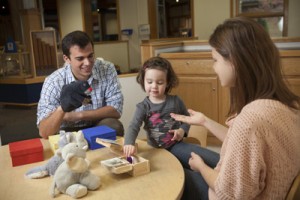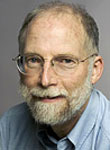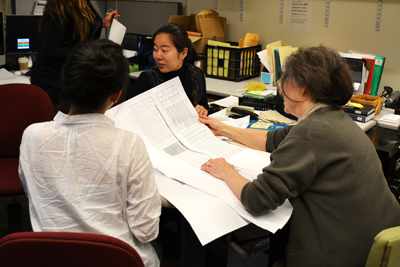Sujin Yang and Barbara Lust
Insights for parents, teachers, educators, and policy makers from research by Dr. , Professor in the Department of Human Development and Director of the Cornell Language Acquisition Lab and by Dr. Sujin Yang, former Post-Doctoral Research Associate at the Cornell Language Acquisition Lab One of the greatest feats of human development is the acquisition of language. Research at Cornell’s Language Acquisition Lab (CLAL), under the direction of Professor Barbara Lust and her students, addresses many aspects of how children acquire language. The research program explores fundamental questions such as which aspects of language acquisition are biologically endowed and which are learned, when and how language acquisition begins, and how multiple language acquisition affects cognitive development in children. Results from this research demonstrate how well equipped children are, beginning at birth, to accomplish the complex task of learning language.
 has long been a center of vigorous research which tries to unlock the mystery of how the child succeeds at this daunting task. At CLAL, language acquisition has been studied in young children across more than 20 different languages and cultures, by teams of graduate and undergraduate students working with collaborators across the world. Now, research within the CLAL is being merged with research being conducted in many other labs in institutions across the country and the world through a new . The newly formed center aims to foster interdisciplinary research including diverse fields such as linguistics, developmental and experimental psychology, and neuroscience.
has long been a center of vigorous research which tries to unlock the mystery of how the child succeeds at this daunting task. At CLAL, language acquisition has been studied in young children across more than 20 different languages and cultures, by teams of graduate and undergraduate students working with collaborators across the world. Now, research within the CLAL is being merged with research being conducted in many other labs in institutions across the country and the world through a new . The newly formed center aims to foster interdisciplinary research including diverse fields such as linguistics, developmental and experimental psychology, and neuroscience.
Current Research
Research results from labs across the world shed light on how the child accomplishes the immense task of language acquisition. They leave us in awe of the intellectual accomplishment of each and every child. In her book, Child Language: Acquisition and Growth, published in 2006, Dr. Lust summarizes many of these results. A few of the major discoveries are highlighted below.
Already at birth, even before they speak or understand language, infants begin processing the speech stream around them in order to determine the sounds of the language (phonology), and the form of the phrases and sentences of the language (syntax). By the time they are 12 months of age, they will have ‘cracked the code’ for many of these properties as they get ready to launch into their first produced words. Here they will show they are mapping what they know about the form of language to what language means (semantics). Over the first 12 months, the infant is conducting many different analyses of the speech stream, working on all the dimensions of language at once (phonology, syntax, semantics.)
Once children begin producing their first words and then combining them into sentences, they will show a complex and abstract ability to map between the sounds of language and its meaning. For example, experimental research has shown that children understand ambiguity in language (multiple possible meanings) and that they are constrained against making random ‘mistakes’ with language. When the English experiment shown in the sidebar was replicated with Chinese children in Taiwan, the results were similar, suggesting biological foundations for this knowledge. (Foley et al., 2003; Guo et al., 1996)
By the time the child is about 3 years old, she or he will have mastered much of the basic system of the language around them.
Children are creative with language. They may make certain ‘errors’ compared to adult language, e.g., the child who calls fruits and vegetables all ‘apples’, but these ‘errors’ are common among normally developing children. In fact, they show the child being abstract, categorical and creative with the language they are working on around them (Golinkoff, & Hirsh-Pasek, 1999).
Children understand many meanings of a sentence. For example, given a sentence like “Oscar (O) bites his banana and Bert (B) does too,” four possible interpretations are possible; (1) O bites O’s banana and B bites B’s banana, (2) O bites O’s banana and B bites O’s banana, (3) O bites B’s banana and B bites B’s banana, and (4) O bites Ernie’s (a 3rd persons) and B bites Ernie’s banana. However, there are six impossible interpretations as well such as “O bites B’s banana and B bites O’s banana.” Experiments show that children understand the multiple meanings of such sentences, but do not form the incorrect meanings. (Foley, et al., 2003, Guo et al., 1996).
Research on Multilingualism in Children
In the CLAL, in conjunction with the VCLA, several research projects are underway which study various aspects of the development of bilingualism/ multilingualism in the young child. One set of studies involves longitudinal case studies of several young children acquiring English for the first time at 3 years of age through immersion in local nursery schools, such as the Cornell Early Childhood Center at Cornell as well as others. Results show that children learning a second language in an immersion setting show an overall success rate of grammatical knowledge similar to English monolinguals. Initial deficit in vocabulary (word learning) was followed by a fast pace of development, ultimately reaching the monolingual mean. Children’s pragmatic competence (e.g., the ability to initiate or join a conversation with peers) progressed slowly during early exposure (e.g., 8th month) but at the later point (e.g., 18th month) considerable improvement over time and many similarities with English monolinguals were displayed.
Another path of research studies children who are developing bilingually and assesses the cognitive effects of bilingualism as compared to monolingualism. This research touches on the ongoing debate as to whether positive or negative cognitive consequences follow from dual or multiple language acquisition during early childhood. A series of research investigations led by Dr. Sujin Yang with children of 4 to 6 years of age and comparison adult groups have been conducted to learn whether learning two languages leads to beneficial outcomes in what is called, “executive function.” These cognitive features in children are of particular interest since they are responsible for selective and conscious cognitive processes to achieve goals in the face of distraction and play a key role in academic readiness and success in school settings (Blair & Razza, 2007, Diamond et al., 2007). Using a neuropsychological and behavioral measure with Korean-English bilinguals, results have already revealed that bilingualism enhances the development of executive attention and facilitates superior performance in bilinguals as compared to monolingual counterparts on executive attention test. (Yang and Lust 2005, 2007; Yang, 2007).
This collection of multilingualism projects, along with many research results from other labs across the world, affirms that children can learn more than one language and they will even do so naturally if surrounded by the languages (Espinosa, 2008; see Flynn, 2003 for third language acquisition). Although some parents and educators may have concerns about the potential for confusion, bilingual children do not suffer language confusion, language delay, or cognitive deficit (Werker, & Byes-Heinlein, 2008; Petitto & Holowka, 2002; Yang & Lust, 2005; Yang, 2007). The mystery of first language acquisition is intensified when we realize that a child can and does naturally acquire more than one language at once.
Tips for parents
♦ Surround the child with as much rich language and language exchange as possible, beginning from birth.
♦ Children learn not only from language you address to them, but from language they overhear around them (Au, Knightly, Jun, & Oh, 2002). Linguistic interaction, can add positive effects on linguistic development.
♦ Although exposure to language is essential, explicit “drilling” is not needed for the normally developing child; parents will not be ‘teaching’ the child so much as the child will discover language; they are as one scholar put it “spontaneous apprentices” (Miller, 1976).
♦ Read to children, encourage them to talk about what is read, and surround them with language through literacy.
♦ Share with your child the joy of words and language.
Raising a Bilingual Child
♦ Cognitive advantages follow from becoming bilingual. These cognitive advantages can contribute to your child’s future academic success.
♦ Social advantages follow from becoming bilingual. By fostering bilingualism (or multilingualism) in your child you make it possible for them to access other cultures and other worlds in ways monolinguals cannot.
♦ Learning and exposure to another language at an early age may produce the best outcomes in attaining native-like language proficiency
♦ Developing bilingualism (or multilingualism) does not impede language acquisition in any language.
♦ Conscious planning and effort may be needed in order to provide the child with an environment that will support more than one language.
♦ Surround the child with more than one language through conversations and social groups using different languages; the earlier the better.
♦ Maintain home (heritage) language when a 2nd language is being learned outside the home.
♦ Expose children to live multilingual settings, often with peers (e.g., play groups).
♦ Provide fun and interactive language learning environments in both languages, often with peers (e.g., music, dance, and film).
♦ Promote reading and story-telling in multiple languages.
♦ Maintain a positive attitude toward languages/cultures children learn.
♦ You do not need to maintain a one person-one language situation; your child will sort out the languages by themselves.
Worried About Delays or Dysfunctions?
♦ Be certain that your child’s hearing has been tested
♦ Be aware that there are large differences in the rate at which children reach their first words or first sentences. These developmental differences are generally perfectly normal.
♦ During the first few years of life, it takes time and a lot of cognitive work on the part of your child to acquire languages. This is essentially challenging since your child is acquiring everything else about the world at the same time.
♦Consult a professional if you are in doubt or concerned.
Further Resources
References
Au, T. K., Knightly, L. M., Jun, S.-A., & Oh, J. S. (2002). Overhearing a language during childhood. Psychological Science, 13, 238-243.
Blair, C. & Razza, R. P. (2007). Relating effortful control, executive function, and false belief understanding to emerging math and literacy ability in kindergarten, Child Development, 78, 647-663.
Diamond, A., Barnett, W.S., Thomas, J., & Munro, S. (2007). Preschool program improves cognitive control, Science, 318, 1387-1388.
Espinosa, L. (2008). Challenging Common Myths about Young English Language Learners. (FDC Policy Brief, Advancing PI-3, No. 8). New York: Foundation for Child Development.
Flynn, S. (2003). Simultaneous vs Sequential Third Language Acquisition Among Children. In Cohen, J., McAlister, K., Rolstad, K., & MacSwan, J. (eds). Selected Papers from the 4th International Symposium on Bilignualism (pp. 768-774). Somerville, MA: Cascadilla Press.
Foley, C., Nunez del Prado, Q., Barbier, I & Lust, B. (2003). Knowledge of Variable Binding in VP Ellipsis: Language Acquisition Research and Theory Converge. Syntax, 6(1), 52-83.
Golinkoff, R.M. & Hirsh-Pasek, K. (1999). How Babies Talk. New York: Penguin Books.
Guo, F., Foley, C., Chien, Y-C, Lust, B. & Chiang, C-P. (1996). Operator Variable Binding in the Initial State. A Cross linguistic study of VP ellipsis structures in Chinese and English. In
Lucus, A. & Paul, W. (eds). Cahiers de Linguistique Asie Orientale 25(1), 3-34.
Lust, B. (2006). Child Language: Acquisition and Growth. Cambridge: Cambridge University Press.
Miller, G. A. (1976). Spontaneous apprentices: Children and language. New York: Seabury Press.
Petitto, L. A., & Holowka, S. (2002). Evaluating attributions of delay and confusion in young bilinguals: Special insights from infants acquiring a signed and spoken language. Sign Language Studies, 3, 4-33.
Werker, J. & Byes-Heinlein, K. (2008). Bilingualism in Infancy: First Steps in Perception and Comprehension. Trends in Cognitive Science, 12(4), 144-151.
Yang, S. & Lust, B. (2004). Testing effects of bilingualism on executive attention: comparison of cognitive performance on two non-verbal tests. Poster session presented at the Boston University Conference on Language Development 29, Boston, MA. Retrieved from http://128.197.86.186/posters/29/YangBUCLD2004.pdf
Yang, S. & Lust, B. (2007). Cross-linguistic differences in cognitive effects due to bilingualism: Experimental study of lexicon and executive attention in two typologically distinct language groups. Proceedings of the Boston University Conference on Language Development (BUCLD) 31. Somerville, MA: Cascadilla Press.
Yang, S. (2007). Impacts of Early Childhood Bilingualism on the Development of Executive Attention: Evidence from the Attention Network Test (ANT). Unpublished Ph.D. Dissertation, Cornell University.
Yip, V. & Matthews, S. (2007). The Bilingual Child: Early Development and Language Contact. Cambridge: Cambridge University Press.
Recommended Readings
Baker, C. (2000). The Care and Education of Young Bilinguals: An introduction for professionals. Clevedon: Multilingual Matters Ltd.
Bialystok, E. & Hakuta, K. (1995). In Other Words: The science and psychology of second-language acquisition. New York: Harper Collins.
Grosjean, F. (1982). Life with Two Languages. Cambridge, MA: Harvard University Press.
Pearson, B.Z. (2008). Raising a Bilingual Child: A step-by-step guide for parents. New York: Living Language.
Tabors, P.O. (1997). One Child, Two Languages. A Guide for preschool Educators. Baltimore, MD: Brookes Publishing Company.
Human Development Today e-News
Human Development Outreach & Extension








